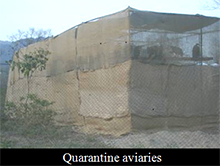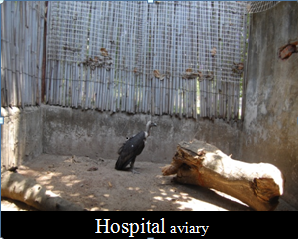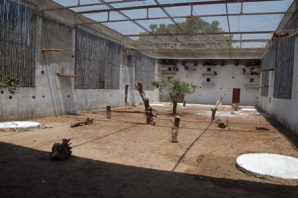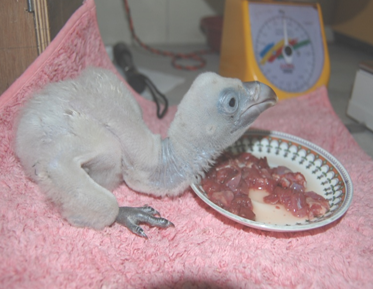Infrastructure & Facilities at Jatayu Conservation Breeding Centre
There are various types of aviaries for keeping vultures of different age and health conditions.
Housing
The salient features and specifications of different aviaries for housing the vultures are given below.
The Quarantine Aviaries
 The Quarantine aviaries (20x20x12′) are located 5 km south of the centre on Forest Department land. There are three temporary aviaries with a capacity to hold 20 birds at a time. The aviaries are made up of iron poles and netlon. The facility provides total isolation to birds to recover from any stress or diseases. Any bird brought to the centre is first kept in these aviaries and their health is monitored for 45 days. Blood and fecal samples are analyzed every fifteen days to make sure they are free of diseases.
The Quarantine aviaries (20x20x12′) are located 5 km south of the centre on Forest Department land. There are three temporary aviaries with a capacity to hold 20 birds at a time. The aviaries are made up of iron poles and netlon. The facility provides total isolation to birds to recover from any stress or diseases. Any bird brought to the centre is first kept in these aviaries and their health is monitored for 45 days. Blood and fecal samples are analyzed every fifteen days to make sure they are free of diseases.
The Hospital Aviaries
 The Hospital aviaries (12x10x8′) house any bird found injured or sick with in the centre, for treatment and care. The centre has four hospital aviaries with capacity to hold a bird each.
The Hospital aviaries (12x10x8′) house any bird found injured or sick with in the centre, for treatment and care. The centre has four hospital aviaries with capacity to hold a bird each.
The Colony Aviaries
The Colony aviaries (100x40x20′) hou house sub-adults and adults of a single species after they have been quarantined for at least 45 days. These aviaries are large enough for the birds to do wing exercises by flying from one end to another and feed socially on carcasses, exactly as they do in the wild. There are three such aviaries with capacity to hold 40 birds. The colony aviaries are equipped with CCTV cameras.
The Nursery Aviaries
The Nursery aviaries (12x10x8′) are designed to provide natural nest like environment to the nestlings. The centre has ten nursery aviaries with a total capacity of rearing at least 50 nestlings at a time.
 The Centre has three Holding aviaries, one of dimensions (60x40x20′) and two of dimensions 20x20x20′ with capacity to hold 10 pairs in the big aviary and 2 pairs each in the smaller ones. The birds are kept in these aviaries after they fledge in nursery aviaries. These aviaries are large enough for the birds to do wing exercise and flap fly from one end to another. The centre has two Display aviaries (25x17x14′). Presently being used as holding aviaries, they will be eventually used as display aviaries for visitors. Vultures which are not fit for the breeding programme will be kept in these aviaries.
The Centre has three Holding aviaries, one of dimensions (60x40x20′) and two of dimensions 20x20x20′ with capacity to hold 10 pairs in the big aviary and 2 pairs each in the smaller ones. The birds are kept in these aviaries after they fledge in nursery aviaries. These aviaries are large enough for the birds to do wing exercise and flap fly from one end to another. The centre has two Display aviaries (25x17x14′). Presently being used as holding aviaries, they will be eventually used as display aviaries for visitors. Vultures which are not fit for the breeding programme will be kept in these aviaries.
Laboratory and Veterinary Care Facilities
The centre has a well-equipped laboratory with the following facilities.
Clinical Room
The Clinical Room (12x10x10′) is equipped with gas anesthesia machine and other equipment required for basic surgery and disease diagnostics. The birds with any sickness or injury are treated here.
Critical Care Room
The Critical Care Room (12x10x10′) is next to the clinical room. It is thermo-controlled and has critical care boxes for keeping birds while recovering from serious illness. The wooden boxes are of dimensions 3×3′.
Recovery Aviary
The birds are released in the Recovery aviary(12x10x8′) after recovering in the critical care room. The aviary is open to sky and has a layer of netlon on the top. The aviary has a similar design as the hospital aviary. The perching in this aviary is done in accordance to the requirement of the bird.
The Brooder Room
It’s utilized for keeping newly hatched nestlings. The nestlings would be hand reared and fed by the staff of the centre with the help of vulture puppets. This will be done to make sure that the nestlings do not get imprinted on humans. The room shares one of its walls with an aviary where handicapped adult birds would be kept. The intervening wall has a one way glass which will make sure that the adult vultures are always in sight of the nestlings.
Incubator Room
 It’s thermo-controlled and has two state-of- the-art incubators with the latest contact incubation technology. The incubator works by having a balloon filled with warm air pushing gently down on the eggs, so only the top half of the egg receives the heat – much like a natural bird sitting on eggs. On a programmed timer – with times of our choice, the balloon lifts off the eggs, the eggs are turned on a roller and the balloon returns down on the eggs, thus warming the other side of the eggs.
It’s thermo-controlled and has two state-of- the-art incubators with the latest contact incubation technology. The incubator works by having a balloon filled with warm air pushing gently down on the eggs, so only the top half of the egg receives the heat – much like a natural bird sitting on eggs. On a programmed timer – with times of our choice, the balloon lifts off the eggs, the eggs are turned on a roller and the balloon returns down on the eggs, thus warming the other side of the eggs.
Molecular Room
It has a PCR (Polymerase Chain Reaction) machine with accessories. The equipment is utilized for sexing birds by using DNA. There is a fully automated blood biochemistry machine which helps in determining the levels of uric acid, albumin, total protein and creatine kinase in blood serum of vultures. The presence of diclofenac in the vulture tissue as well as cattle carcass tissue is detected with the help of ELISA reader also present in the lab.
Haematology Room
 The Haematology Room (12x12x10′) has all facilities for carrying out routine hematology on vulture blood. The lab has a powerful Leica microscope, centrifuge machine, a Haemacue, a blood mixer and other relevant instruments and accessories to carry out haematology.
The Haematology Room (12x12x10′) has all facilities for carrying out routine hematology on vulture blood. The lab has a powerful Leica microscope, centrifuge machine, a Haemacue, a blood mixer and other relevant instruments and accessories to carry out haematology.
The Closed-Circuit Television Camera Monitor Room
The Closed-Circuit Television Camera Monitor Room (10x10x10′) is utilized for carrying out observations on the birds. All three colony aviaries are equipped with CCTV cameras to study vulture behaviour. The camera pans and tilts up to 180º. It has a zoom of 20-27X. Every corner of the colony aviary can be monitored with the help of these cameras.
Freezer Room
The Freezer Room(12x10x10′) has three -20ºC freezers for storing important tissue samples of vultures.

